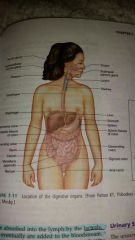![]()
![]()
![]()
Use LEFT and RIGHT arrow keys to navigate between flashcards;
Use UP and DOWN arrow keys to flip the card;
H to show hint;
A reads text to speech;
22 Cards in this Set
- Front
- Back
- 3rd side (hint)
|
Alimentary canal or digestive tubes consists of what? |
The mouth, esophagus, stomach, a small intestine, large intestines, the rectum , and anus |
|
|
|
The accessory organs of digestion includes what? |
The liver, pancreas and gallbladder |

|
|
|
Process of mastication(chewing) |
The food is ingested into the mouth where it is mechanically broken down by the teeth and tongue |
|
|
|
Saliva |
Produced by three pairs of salivary glands, lubricate and dilutes the chewed food |
|
|
|
Amylase |
Saliva contains an enzyme that starts the digestion of complex carbohydrates |
|
|
|
Bolus |
A ball of food that is formed |
|
|
|
What happens when food swallowed? |
Constrictive muscles of the pharynx forces the food into the upper portion of the esophagus , and the food is swallowed |
|
|
|
Esophagus |
A narrow tube leading from the pharynx to the stomach |
|
|
|
What are the four main layers of the digestive tract from intermost to outer? |
The mucous membrane , the submucous layer , the muscular layer, and the serous layer |
|
|
|
What happens when food is digested? |
Food enters the stomach with gastric glands secrete hydrochloric acid that breaks down food. The stomach muscle churns and mixes the bolus of food turning the mass into a soupy substance called chyme |
|
|
|
Chyme |
Soupy substance produced when the stomach muscle churns and mixes the bolus of food |
|
|
|
What happens in the small intestine? |
Digestion and absorption of food occur. |
|
|
|
What does the pancreas do? |
Contributes water to dilute the chyme and bicarbonate ions to neutralize the acid from the stomach |
|
|
|
The small intestine consists of what three major regions? |
The duodenum, the jejunum, and the ileum |
|
|
|
What happens in the small intestine regions? |
Nutrients are absorbed through the walls of the small intestine. The amino acids and simple sugars derived from proteins and carbohydrates are absorbed directly into the blood. Fats are absorbed into the length of the lacteals, which eventually are added to the bloodstream. All nutrients then enter the hepatic portal vein to be routed to the liver for decontamination. |
|
|
|
Villi |
Small finger-like projections that greatly increase the surface area of the intestinal wall. |
|
|
|
Large intestine |
Reabsorbs water and stores and eliminates undigested food. Here also are abundant bacteria, the intestinal Flora |
|
|
|
What are the five portions the large intestine is arranged into? |
The ascending colon, the transverse colon , the descending colon, the sigmoid colon , and the rectum |
|
|
|
Anus |
The opening for defecation (expelling of stool) |
|
|
|
What increases the surface area for digestion? |
The muscular movements of the stomach and intestines also result in mechanical breakdown of food and an increase of surface area |
|
|
|
What happens during mastication? |
Teeth reduce ingested food material to smaller particles to increase surface area for chemical digestion |
|
|
|
Liver |
The liver's main job is to filter the blood coming from the digestive tract, before passing it to the rest of the body. The liver also detoxifies chemicals and metabolizes drugs. As it does so, the liver secretes bile that ends up back in the intestines. The liver also makes proteins important for blood clotting and other functions |
|

